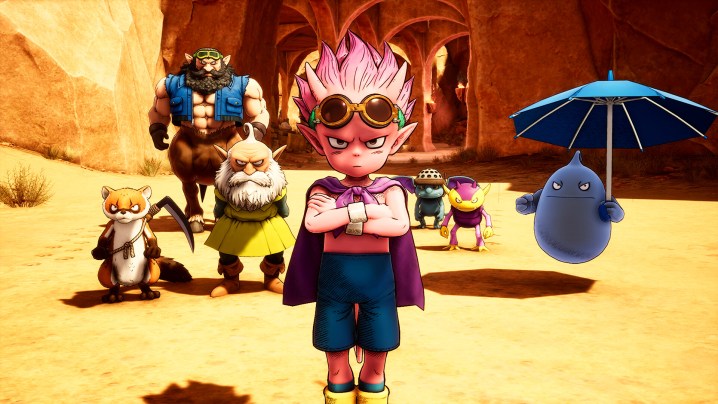“Sand Land is a definitive adaption of a great Akira Toriyama manga, but just fine as a game.”
- A faithful adaptation
- Enjoyable vehicle combat
- Rewarding sidequests
- Beautiful art
- Second half's story is weak
- Unpolished melee combat
- Generic open-world activities
The fun of adaptations comes from seeing moments in one medium reimagined for another. We often see that when books become films, but video games provide a unique opportunity to tease more depth out of static source material through play. Take Sand Land, a manga I recently read and enjoyed following the death of creator Akira Toriyama, that has just been turned into an open-world action game by Bandai Namco Entertainment. I was delighted to play familiar moments straight from the page, its characters driving away from a sandworm-like Geji Dragon or fiend prince Beelzebub facing off against Insect Men.
Those moments brought me back to the licensed games I grew up on, the kind that has fallen by the wayside as games get more expensive and game development timelines increase. Games like The Incredibles or SpongeBob SquarePants: Battle for Bikini Bottom felt like the most faithful video game adaptations we could get, even if they weren’t the most polished or innovative titles out there. Sand Land, which is releasing alongside a new anime that retells the manga’s story and continues the tale, feels very much of that ilk.
Although I do think that this is the definitive game adaptation that Sand Land could have gotten, it struggles to punch above its weight class. It unequivocally gives the franchise a thorough video game adaption, so Toriyama fans can rest easy. Just don’t go in expecting it to be anything more than that.
Adapting and expanding
Sand Land’s adventure begins with Beelzebub, the prince of demons, teaming up with a human named Rao in order to find a legendary spring in the middle of a desolate desert. The manga is one of the most underrated works of Dragon Ball creator Toriyama. Its story feels more relevant than ever with the climate crisis we face, especially as it shines a spotlight on how self-serving rulers will hamper progress if it gives them a modicum of money or power.

When Sand Land adapts the manga for the first half of its adventure, it’s an engaging adventure filled with well-handled recreations of classic moments. That’s exactly what I want out of a licensed game adaptation. Unfortunately, the Sand Land game doesn’t end where the manga does.
When Beelzebub eventually destroys a dam blocking water from entering Sand Land, that opens up a whole new conflict that dominates the back half of the adventure. Apparently, Sand Land isn’t the only kingdom in this world, and it ends up going to war with the nearby Forest Land. Although I understand it’s adapting the story written for the new anime, the new narrative twist underwhelms.
The added story content embraces more stock anime tropes than its creative source material …
The conceit of Sand Land not having any water makes a lot less sense when Forest Land emerges as a place it’s possible for characters to travel between. The fact that the antagonists from this realm and the lore associated with them are introduced at the game’s midpoint also meant I didn’t have the time to really get to know or care about the villains as I did for our heroes.
The added story content embraces more stock anime tropes than its creative source material, like more cliché rivals or scenes where characters stop and talk during a battle when it doesn’t quite make sense to do so. It’s no surprise that the first half — the part directly pulled from a visionary creator’s work — is stronger than the inventions of a team building on it.
Tank time
If you were to ask what I want out of a Sand Land video game adaptation, I’d say an open-world adventure with an emphasis on tank and vehicle combat. That’s exactly what Bandai Namco Entertainment and developer ILCA delivered. Sand Land and Forest Land both have sizeable open worlds that players can explore in vehicles or on foot. I prefer to spend most of my time in vehicles, starting with a tank and expanding to jump-bots, motorbikes, hovercars, and more.
Vehicle combat is polished, albeit straightforward.
Each vehicle has a unique utility. The tank is the most useful in combat, the bike can cover large distances really fast, the hovercar can ride over water, and the jump-bot can reach high-up ledges that might house hard-to-reach materials or chests. It feels intuitive to switch among them (although I mostly found myself using the tank rather than swapping vehicles).
Vehicle combat is polished, albeit straightforward. As long as I keep shooting at enemies and boost away as a shot comes toward me, I come out on top. The developers likely hope that the main draw is how players can customize vehicles. As players explore, they’ll find a variety of crafting materials and even weapons or chips for vehicles. Players can craft, customize, and upgrade vehicles at garages or rebel bases.

After completing a certain sidequest, it’s possible to further customize the color schemes and decals on these vehicles too. There’s quite a bit of depth here, and Bandai Namco Entertainment has certainly carved out a vehicle and mech customization niche for itself with Sand Land, its Gundam games, and Armored Core VI: Fires of Rubicon. It’s not nearly as punishing as that last game, though. As long as I equipped the most powerful parts I found, I tended to fare just fine in any combat encounter the main story threw at me.
Certain dungeons, towns, and story missions force Beelzebub to travel around on foot. While doing so, he can more delicately platform up ledges or take on enemies in melee combat. That sometimes plays out from a 2D platformer camera perspective. Unfortunately, melee combat pales in comparison to vehicular battles. Attacks are slow, combos are basic, and the lock-on camera is wonky. And even then, fistfights are still a cakewalk on normal difficulty. Even though I love Beelzebub’s character design, I much preferred the gameplay when he was stuck in a vehicle.
A boilerplate open world
Sand Land’s open-world design is nothing spectacular. Its maps are dotted with fast travel points, and in between those are a variety of sidequests, open-world activities, and caves filled with loot. It’s much more in the vein of Ubisoft’s open-world design rather than that of The Legend of Zelda: Tears of the Kingdom or Dragon’s Dogma 2. The open-world activities are a mixed bag, with instant-fail stealth missions being the worst of the bunch.
Sidequests have palpable rewards and don’t just feel like entries on a checklist.
Thankfully, Sand Land’s open-world exploration isn’t a complete bust thanks to its sidequests. I’ve written about how good sidequests can make or break a game like Final Fantasy VII Rebirth, and thankfully Sand Land does them well. They all feature original characters with memorable, Toriyama-inspired designs. Some of their stories can be surprisingly compelling too. When the main narrative started letting me down, I found myself gravitating toward those optional stories.
Many of the sidequests effectively feed back into Spino, a town players encounter early on in the adventure. As more people are sent back to Spino, the town grows with a variety of vendors that deepen gameplay and customization options. Sidequests have palpable rewards and don’t just feel like entries on a checklist. Unfortunately, the rest of Sand Land’s side activities don’t meet that bar.

Sand Land is a very safe video game adaptation. There’s nothing particularly stunning about its open-world design or vehicle combat, even if its Toriyama-style art looks great. That makes its flaws all the more noticeable as the story worsens in its back half and open-world activities become even more tedious.
Although this is about what I expected from a Sand Land video game adaptation, I believe this story and world have the potential to go above and beyond where it currently is. Fans of Sand Land should have a good time here, and I could see this being a formative licensed game for some younger players. But if you’re unfamiliar with the source material, read the manga first.
Sand Land was tested on PlayStation 5.




